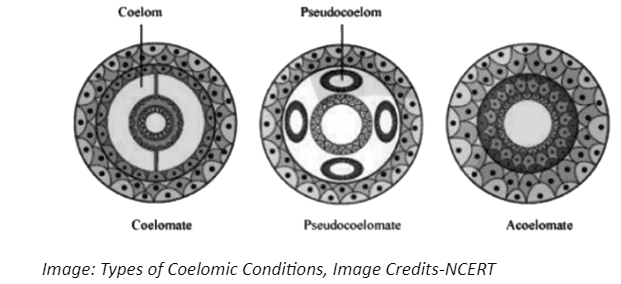NCERT Solutions Chapter 4 -Animal Kingdom Class 11 Questions and Answers FREE PDF Download
FAQs on NCERT Solutions for Class 11 Biology Chapter 4 Animal Kingdom
1. What is the importance of body coelom and cavity in the classification of animals?
The coelom is the fluid-filled or body cavity space followed by the mesoderm. Animals possessing coelom are called coelomates. The body cavity in some animals is not filed by mesoderm; instead, it is presented as deranged pouches in between the endoderm and ectoderm. This body cavity is called pseudocoelom, and the animals who are possessing them are known as pseudocoelomates, for example – aschelminthes. Animals whose body cavity is absent are referred to as acoelomates, example – Platyhelminthes. The classification of coelom and body cavity are essential to determine the complexity of an animal at the organ level.
2. Why are the arthropods the largest species among the animal kingdom?
Arthropods are the most thriving animals and form the largest group of the Animal Kingdom. They have captured land, sea and air and are known as the three fourth of currently identified living and fossil organisms. They rank in distribution from mountain peaks to the deep sea. The thick, non-living chitinous integument develops the exoskeleton which shields the organism from predators, prevents water loss and helps to resist the temperature up to 100°C or more. They can reproduce very fast, and in less time. Cockroaches, an example of arthropods can even endure nuclear radiations. All these factors make arthropods the largest species among animals.
3. What are the important topics in Animal Kingdom Class 11 NCERT solutions?
Class 11 biology chapter 4 question answers cover important topics such as:
Basis of Classification
Classification of animals
4. How many questions come from Class 11 Biology Chapter 4?
Biology Class 11 Chapter 4 comes under Unit 1. To know the types of questions that can be expected, students are recommended to refer to the Animal Kingdom questions and answers and the study materials provided by Vedantu. About 10-12% of the questions from past trends might be from this unit.
5. Which phylum is important in the animal kingdom?
Arthropoda is the most important phylum in Class 11 Biology Chapter 4 due to its abundance and diversity. Arthropods are the largest phylum, with over a million species, including insects, crustaceans, and arachnids. Students are advised to thoroughly understand the concepts covered in Class 11 biology chapter 4 question answers for their board exams.
6. What is unique about Animal Kingdom Class 11 questions and answers?
Class 11 Animal Kingdom NCERT solutions cover the entire range of questions expected in board exams. Vedantu provides the Animal Kingdom Class 11 NCERT PDF specifically designed for students navigating through the concepts of this chapter.
7. Are the Class 11 Animal Kingdom NCERT solutions free of cost?
Yes. Students can access Animal Kingdom questions and answers available on Vedantu’s website, along with study materials and Animal Kingdom questions and answers PDF to learn better and prepare for exams.
8. Where can I find Animal Kingdom Class 11 NCERT solutions?
Vedantu provides all the information related to Class 11 Biology Chapter 4 for a comprehensive understanding of students and to clear their doubts about this chapter.
9. What is the basic difference between classification and identification?
Classification divides organisms based on their characteristics, whereas identification involves the determination of species of unknown organisms.
10. What classification levels are used in Class 11 Biology Chapter 4?
The levels of classification are as follows:
Kingdom
Phylum
Class
Order
Family
Genus
Species

























